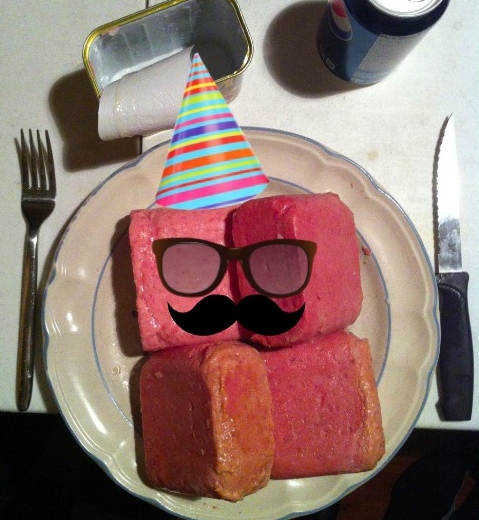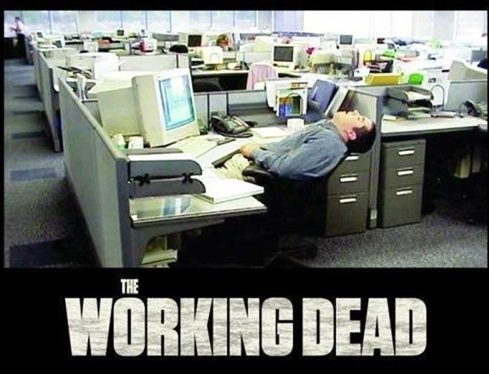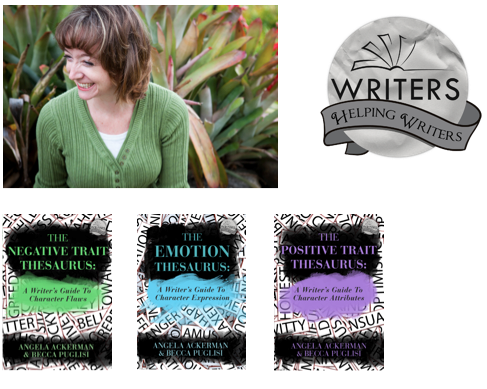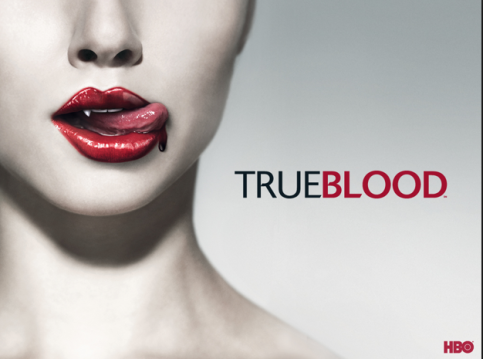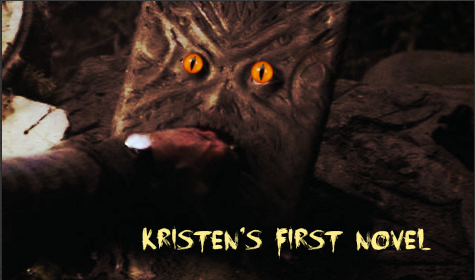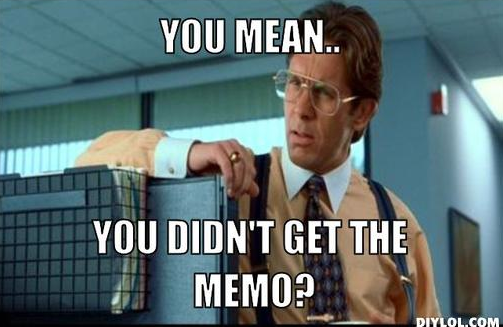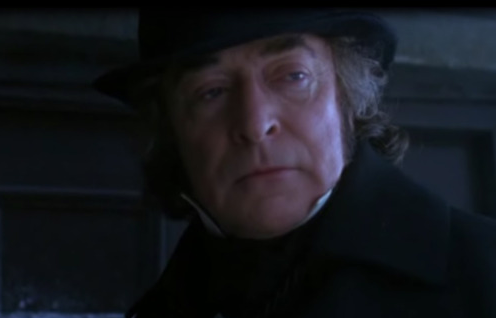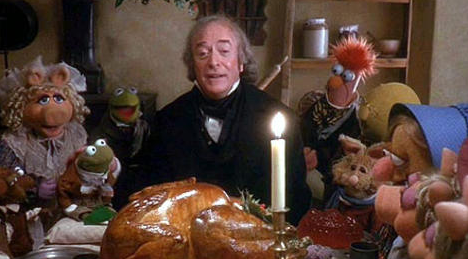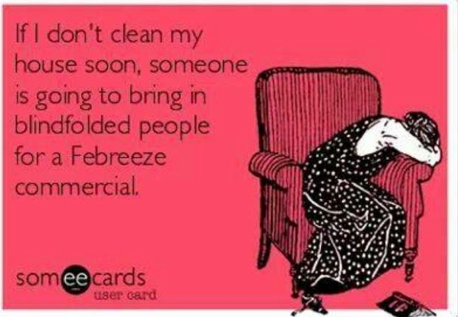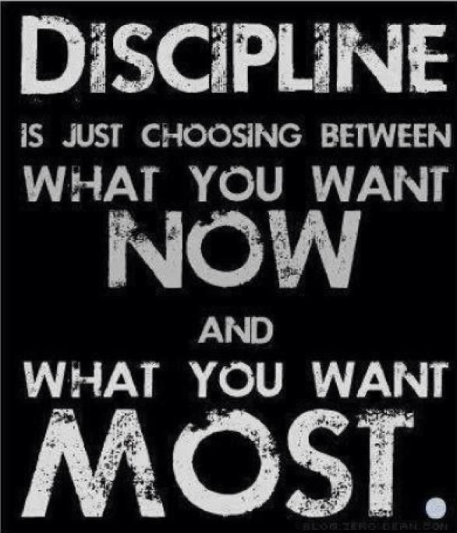Kristen Lamb's Blog, page 55
January 9, 2015
8 Ways to Make People on Twitter Want to Stab Us IN THE FACE
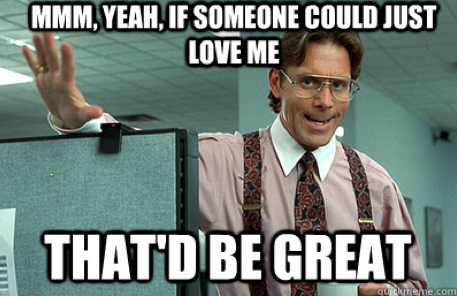
Image via QuickMeme
One would think a lot of what I teach about social media (Twitter) would be self-explanatory, but hey…we live in a world where a box of frozen corn dogs has a warning that I need to REMOVE the corn dogs from the box BEFORE placing in oven. Hell, who KNEW?
As a social media expert, I run into all kinds of strange behavior and tips that make me scratch my head. Social media is social, meaning it’s supposed to be an extension of how we might interact with other human beings in person. Today’s post (obviously) is tongue-and-cheek, but humor can be the best teacher even if we’ve oopsed.
Tip #1—Only Use Automation
Writing a 140 characters is SUPER time-consuming. We aren’t Jack London. Besides, people LOVE talking to robots. I know when I feel lonely, I call AT&T because I know a human being will NEVER answer…EVER. Humans can be so boring and don’t offer us the option of hitting 6 if we want to hear everything they just said all over again.

Yeah, all my BFFs send me automated messages.
Real Life Application: Program cell phones to call friends and family at regular intervals to ask for money. They’d dig that.
Tip #2—Make Sure All Preprogrammed Tweets are “Carefully Crafted”
Because when we take time to artfully craft our spam, people don’t mind. They LOVE believing a real person is there only to be fooled. It’s like when that cute guy/gal in high school pretended to want to go out with us. Now we can relive that experience as adults by being duped into thinking we were chatting with a real person who actually cared.
Real Life Application: At the holidays, volunteer to bring a Honey-Baked ham, then show with Tofurkey. They won’t know the difference if we use lots of ketchup.
Tip #3—When Programming Tweets Include Popular Hashtags
Who goes to social media to socialize? People LOVE finding a community of real people to talk to and then having it crowded out by the same advertising over and over…and over. Because research shows that it takes at least 20 times to see an annoying face before we want to punch it.
Real Life Application: When attending any party, make sure to hand out lots of fliers, advertisements and coupons. Have a children’s book for sale? Stake out bounce house parties and put ads in all the little grab bags. Kids don’t want toys, candy and stickers, they want our BOOKS. Feel free to crash weddings, graduations, bachelor parties and maybe even funerals. If potential readers aren’t coming to us, we should go to them. Find where they gather then SELL. So what if it’s against their will?
Tip #4—Make People Prove Who They Are Before Talking to Them
Twitter validation services are awesome. We love meeting someone, only to have to jump through hoops to prove our love. We even get the added advantage of being redirected off Twitter to an outside site where we’re easily hacked.
How else will all our friends receive direct messages from porn sites posing as us? Nothing seals an on-line relationship like giving others a social media disease. Who will they think of when they have to spend hours removing viruses and trojans from their computers.
Can we say “Top of Mind”?
Come on! It takes three whole seconds to unfollow a bot. We need those precious three seconds to carefully craft witty preprogrammed tweets. Let the other person do the fifty hoops of leg-work to earn our trust. They have plenty of time.
Real Life Application: Whenever we meet someone and start chatting, if we like them, halt all communication until they fill out a detailed background check. Throw in a pee test to be extra sure ;).
Tip#5—Tweet LOTS of Articles—Ok, ALL Articles
Most of us, when we wake up in the morning, think, “Gee, I wish I had a super long reading list. I sure miss my college syllabus.” Those of us with a corporate job LOVE people who hit Reply ALL so we can read more. Wikipedia is a hot place to hang out. Why not bring that encyclopedic magic to Twitter?
Real Life Application: Make sure to print off a box of articles for that wedding you were invited to. Who wants to dance or flirt when they could be reading about Three-Act Structure or Intestinal Parasites? Handing people a stack of reading material is way better than getting trapped in a “conversation.”
Tip #6—Ask for Stuff Immediately

Oh, sure! Let me drop everything to buy your book.
The second someone befriends us, it’s our job to send an automated link to their Direct Messages so they can do stuff FOR US. Buy our book, like our FB page, follow our blog, or even answer a really inane question (as if we care about their answer) *rolls eyes*. Hey, great to meet you. Do you like vampires or werewolves?

Huh?
Real Life Application: If someone is nice to us in the grocery store, make sure to have books to sell and the ability to take credit cards on the spot. Sure, that person is trying to buy a chicken to make for dinner and now she can buy OUR BOOKS, too. Win-win. If we don’t have books for sale, we can ask for life, love or career advice from total strangers, because that isn’t creepy at ALL.
Tip #7—Tweet from Several Accounts/Identities
People on Twitter might miss out on all those “carefully crafted” preprogrammed tweets. Make sure to have anywhere from 2-7 identities sending the same messages. What’s better than spam? MORE SPAM, duh.
Real Life Application: This tactic ROCKS for singles on the dating scene. Meet a date then several times throughout the conversation, change names and accents. Multiple-Personalities are just more people to love.
Tip #8—Never Tweet ANYTHING Original Just Retweet
Again, 140 characters cuts into word count. Save time and retweet what everyone else has to say. Two clicks? DONE.
Real Life Application: Repeat what everyone else says. People love parrots, so why not harness that fluffy colorful cuteness? I know I LOVED it when my little brother repeated everything I said…until I put him in an arm-bar.
Okay, Serious Now
Twitter can be very valuable and a great place to make wonderful friends. Be real and enjoy. People are on social media to be social. We crave connection, fun and escape. If we wanted more ads we’d read the door in the bathroom stall or not bother fast-forwarding through commercials. We don’t need to be profound, deep or immensely witty to do well on Twitter, we just need to be vested, present and authentic ;).
What are some other things people do on social media that in real life would be ridiculous? I think sometimes we fail to extend that logic. Do you get tired of the same automation tweets? Have you ever bought a book because someone you friended automatically sent you a link to buy?
I LOVE hearing from you!
To prove it and show my love, for the month of JANUARY, everyone who leaves a comment I will put your name in a hat. If you comment and link back to my blog on your blog, you get your name in the hat twice. What do you win? The unvarnished truth from yours truly. I will pick a winner once a month and it will be a critique of the first 20 pages of your novel, or your query letter, or your synopsis (5 pages or less).
For those who need help building a platform and keeping it SIMPLE, pick up a copy of my latest social media/branding book Rise of the Machines—Human Authors in a Digital World on AMAZON, iBooks, or Nook.

January 5, 2015
The Art of Business & The Business of Art—Breaking Rules to Reveal Our Audience
There are a lot of fabulous blogs and books on business, especially for writers. How to promote, do a tour, switch an algorithm, etc. But, I tend to be a broad strokes kind of gal. I dig simple. Simple works. Simple doesn’t have an expiration date.
ART is a Business & Business is an ART

Image via Flickr Creative Commons, courtesy of Mark Roy.
When companies forget they are servants and act in a way that makes consumers serve them? That’s when they get into trouble. Businesses are in business to…make money. NO. Businesses should be in the business to serve people.
Artists are in the business of “making and selling art.” NO. They should be in the business of serving the audience. It is a TWO-WAY dialogue driven by core needs.
This is where many writers need to breathe into a paper bag because they break out in hives at the mention of “business.” But, if we want to create anything that people want to PAY MONEY for? We are a business.
Be the Consumer
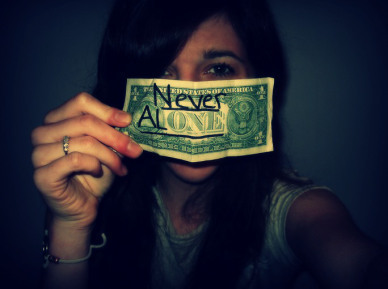
Image via Demi-Brooke Flickr Creative Commons
The power of empathy is particularly crucial. Humans are actually very simple. Most of our decisions are driven by the primal brain. We like to feel good about a purchase. We often can’t articulate WHY we made a decision because it is the non-verbal part of our brains at the steering wheel when we choose.
Also, the product is all about US.
Friday, when we talked about breaking rules in writing, there was a lot of mention about writers simply breaking rules to break them. Yet, I would challenge every artist (or business) to step back and feel. Think about the customer FIRST and ego second. Money LAST.
Case in Point
I never set out to be the social media expert for writers. Yet, as early as 2003, I knew social media would completely alter the publishing paradigm. Anyone who bought an MP3 and had an ounce of imagination could see the domino effect ahead.
Tower Records–>Kodak–> Big Six Publishing
I was very grateful for the computer and marketing people who attended conferences to teach social media, but I had a couple of problems.
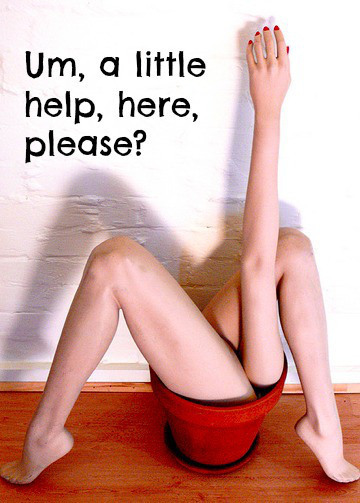
Image via Flickr Creative Commons, courtesy of Sally Jean
First of all, I knew writers would eventually HAVE to have a brand and social media platform or be dead in the water. The problem was that these computer people didn’t know how to talk to creative people who had trouble opening their e-mail. At the time, many writers (and editors and agents) refused to even USE e-mail.
Thus the presentations actually scared people because they didn’t empower them.
Writers mentally checked out because the computer people made “branding” and “platform-building” too time-consuming and complicated.
The marketing people did the same thing (and, in my mind, many of their tactics were from a 20th century playbook). Their approach didn’t fit into a world where everyone was instantly connected and the flow of information was dynamic and light-speed.
I.e. Having a Facebook Fan Page for EVERY BOOK. Really? O_o When the heck would we have time to WRITE?
Additionally, one thing I noticed (being a salesperson for many years) is these experts failed to consider their audience. They were talking code, algorithms, apps and technology to a group of people who averaged (at the time) over 50. Writing, when I started, was something people often did when they retired or the kids were out of the house.
Their CUSTOMER was my mother who was afraid she’d delete the Internet, yet they failed to connect with “her” in a meaningful way.
As far as the marketing and PR people? There was far too much high-pressure sales involved in their methods. Yet, NO WRITER in the room was thinking, “Hey, I am just going to write about dragons until my dream job in high-pressure SALES comes along.”
I don’t want to be presumptuous, but I noticed many of these early experts had “affordable packages” available. In my mind, they were scaring the audience into feeling powerless in order to sell them something.
That ticked me off.
Ticked me off enough to write my first book, We Are Not Alone–The Writer’s Guide to Social Media. I made it a point to think from the perspective of my customer. MY mission statement was to serve my customer, not the other way around.
I knew writers often were not able to write full-time. Many of us have spouses, kids, a day job, older family members we care for. We needed an approach that was simple and that didn’t have to be outsourced. Many new writers don’t have a lot of money. They couldn’t plunk down $10,000 for a PR guru.
Also, social media and the Internet shifts faster than any of us can keep up. Amazon is constantly changing and if our focus is on juking those changes, we will be like my cat who can never quite catch the red dot. That was WHY I wrote my latest book Rise of the Machines–Human Authors in a Digital World. ONE book. One manual.
Thus, when we talk about breaking rules in business or in art, it MUST be to better serve our audience/customers. It must be SIMPLE and it MUST BE TIMELESS.
When we are being clever simply to be clever? Good luck.

The Reliant Robin: Image via “Top Gear”
I’ve read authors who were being artistic and decided they didn’t need quotation marks or tags. Yet, I ask: How does this help the reader consume the story with page-turning passion?
I could be super clever right now and write a novel in text speak, but who (now) wants the brain cramp of rdng 4 OMG hrs w/ppl txtng & LOL as u DYH or STHU?
Um, but it is my ART *sniffs and rearranges beret*
Why Should We Break Rules?
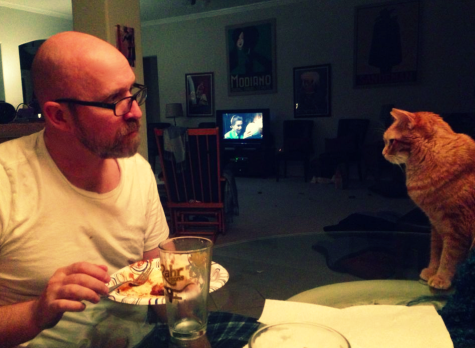
Because it MIGHT just pay off! ~Johnny Cat
All rule-breaking (in my POV) must be to better serve the consumer not the creator. Though I am not particularly fond of Hemingway’s writing, he was a journalist. Fiction, at the time, was BLOATED.
Yet, people in Hemingway’s time finally had photographs, film and newspapers. They KNEW what a whale looked like, so why insult them with a 100 pages describing one?
I imagine this overwriting drove a journalist nutso, and it took a journalist to whittle fiction down to the bones and bare form story.
See, when Melville write Moby Dick he was serving the audience/consumer of his time. He didn’t make the assumption his potential readers were all world-travelers and had seen what he’d seen. Thus, all those details were important for HIS readers.
But, as technology and the world changed, that massive amount of description and exposition were no longer necessary and actually got in the way of the story. It insulted the reader’s intelligence. I feel this was probably a driving force behind Hemingway field-stripping prose.
Did everyone LOVE Hemingway? No. There are people like me who like more description. BUT, there was obviously an audience who appreciated that an author finally wasn’t wasting their time using every fancy adjective, adverb and metaphor they could stuff into a paragraph.
Breaking Rules Begins with a NEED and a Vacuum
When I started writing about social media it was because no one was saying the things I needed to hear. I needed something simple, timeless and effective. WANA methods worked in 2008 and they still work today because they are simple and functional.
Instead of trying to alter the authors’ personality and make them rely on all their weaknesses, I created a method that harnessed the writers’ personality and allowed them to play to their strengths.
This is why artists can be particularly good at business once the fear-factor is peeled away. We have great powers of empathy. Remember, in the last post, I said our goal is to write the book people don’t yet know they want.
Angela Ackerman and Becca Puglisi wrote a FABULOUS series of craft books because there were none like the ones they as authors needed. They, themselves wanted simple and effective tools deepen characters, yet none were available…so these gals stepped in and WROTE them. I HIGHLY recommend just getting them all. The Emotion Thesaurus, The Positive trait Thesaurus and The Negative Trait Thesaurus.
If you are SERIOUS about writing a great book this year, just go use that gift card you got for Christmas and get these books, today.
Moving on…
Giving Consumers What They Don’t Know They Want
Henry Ford once said if he’d have asked customers what they wanted, they’d have requested a faster horse.
When social media became a game-changer, my potential customers wanted the Internet to implode. They wanted things to remain the same, even though the paradigm of the time was highly unfavorable to writers. As of 2006, writers had a 93% failure rate. Yet writers (like all humans) feared change.
Here’s the thing, anyone literate can write. This means anyone literate could write a book, right? But what is different about us as artists? The world relies on our eyes. We see what others can’t.

I saw THIS in the future…
I saw that brick-and-mortar was crumbling and that social media would eventually empower authors. Though many writers kicked and screamed and begged for the Web to eat itself in a digital black hole, I knew in my heart that was BAD (and wouldn’t happen anyway). Time would prove what I believed. I merely had to stick to my guns no matter how many hateful comments I got on my blogs.
In my heart, I knew I was serving my audience.
Business & Art
Hemingway reinvented writing because he didn’t like all the fluff. He wrote the book he wanted to read and took a risk others would read his books and like them, too. Instead of doing what everyone else was doing, he did something different.
When we break rules, instead of “being different” we should “differentiate.” We need to follow our passion and look for the vacuum yet to be filled.
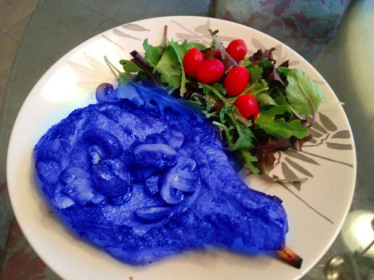
BLUE STEAK. But look how CLEVER it is! Really, it’s YUMMY.
I’ve done business consulting and one of the first things I advise is for the company to pull the annual reports of their top five competitors. Annual reports are dreadfully boring but highly valuable.
What are these companies bragging about to their share-holders? Well, their strengths, duh. Is that where a new business/entrepreneur will find their niche? NO. And, btw, it is the DUMBEST place to try and compete.
The trick is to look at the reports and see where their competitors are struggling. What they are promising to improve (or even fail to mention but should be there)? Find that gap and there is your business plan (book idea).
Breaking Rules in Creating

*giggles*
If we are simply writing retreads of everything already available, we aren’t differentiating.
Oh, but my vampires glitter, they don’t SPARKLE.
Nooooo, that is being different, not differentiation.
Anne Rice is almost solely responsible for CREATING the vampire craze because she dared to write a book from the vampire’s perspective and stuck to her guns even when criticized.
Charlaine Harris asked a “What if?” with her Southern Vampire Mysteries.
What if vampires have always been around but hidden because they had to feed on human blood? What if that blood could be synthesized and vampires could “come out of the coffin”? What would the world be like with predator and prey trying to coexist? Could they?
POOF! Formula for best-selling books and the highly popular HBO series True Blood.
T. Jefferson Parker broke the rules in his thrillers when he mixed first person and third person and he chose to write the ANTAGONIST’S perspective in first-person.
But, he didn’t do this to be clever.
When T. Jefferson Parker writes from the perspective of a car thief or a gun-runner in first-person, we (the reader) are more intimate with them. We understand their whys and become emotionally vested. This increases tension because we find ourselves often rooting for the bad guy even when we know we probably shouldn’t.
This literary device is unique. It stretches our empathy and our minds.
***Note, this is why understanding rules helps us effectively break rules.
J.K. Rowling wrote Harry Potter from inspiration, but she stuck to it despite rejection because, in spite of what she was being told, she believed a YA male protagonist would be popular. So did Jonathan Maberry in his Rot & Ruin series.
These authors not only soul-searched for the book they wanted to read but wasn’t there, but they looked to what books weren’t being written.
We can criticize 50 Shades of Grey all we want, but E.L. James wrote the books she wanted to read and the ones no one else was offering.
All these authors created the books readers didn’t yet know they wanted to read. They all broke rules, whether it was asking a new question, playing with POV, offering up a teenage boy protagonist when most readers are female, or even whips, chains and handcuffs.
This is to say, READ. Books are not so cost-prohibitive that we are really “competition” for each other. It’s why teamwork works so well in our world. People generally will buy/read more than one book.
When we read the genres we love (that we are writing in), look at the strengths, but take time to ponder what you might be able to do differently. What could you possibly combine that normally doesn’t go together? What audience has no voice?
Get in the head of your audience and look for what you have in common. What is the need your book can fill? Write what scares you, because it probably scares your readers too.
Maybe it is a sexy 53 year-old spy, a vestige of the Cold War relegated to being invisible because of age….but she is fit and sexy and KICKS @$$.
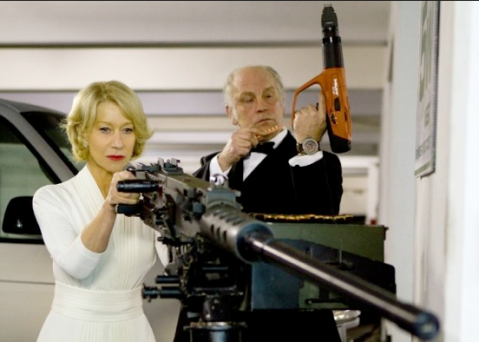
From the movie “Red”
Maybe the protagonist struggles with her weight or an eating disorder. Perhaps your male protagonist struggles with how to be strong in a world where strong males get a lot of pushback. Or maybe he has a learning disability but that turns out to be why he is the perfect hero.
Perhaps it is an underrepresented ethnic group or writing from the perspective of those most overlooked. Sure, we have dozens of Navy SEAL books because SEALS are “hot”, but what about the brand new Airman in Supply who uncovers a vast conspiracy but no one will listen?
Your audience wants to see a part of themselves in your work. How can you do this better?
Just getting the brain-gears moving :D .
We will continue to explore ways that art and business merge, how to be creative and how to better serve our customer (reader). Some ways to create an edge in this highly competitive world. Just remember that success is about simplicity and service. Stick to those? And that’s a great foundation.
I LOVE hearing from you!
To prove it and show my love, for the month of JANUARY, everyone who leaves a comment I will put your name in a hat. If you comment and link back to my blog on your blog, you get your name in the hat twice. What do you win? The unvarnished truth from yours truly. I will pick a winner once a month and it will be a critique of the first 20 pages of your novel, or your query letter, or your synopsis (5 pages or less).
Winner for DECEMBER is Chris Phillips. Please send your 20 pages (5000 words) in a WORD DOCUMENT to kris teen at wan a intl dot com. Or you can send a query letter or five page synopsis (1250 words) in a WORD document. Congratulations!
For those who need help building a platform and keeping it SIMPLE, pick up a copy of my latest social media/branding book Rise of the Machines—Human Authors in a Digital World on AMAZON, iBooks, or Nook.

January 2, 2015
Here’s to Breaking Writing Rules—Rebels With a Cause or Rebels Without a Clue?

Orignal image via Wikimedia Commons
For the past several years, I’ve always begun the New Year with predictions of what the publishing industry would or wouldn’t do in the year to come. But this year? I’m being a rule-breaker and taking a different perspective—one I believe has greater impact and longevity. Algorithms rise and fizzle, publishers go out of business, change paths, or change rules. Heck, Amazon changes its mind more than my mother trying to pick a restaurant. So…eh. Not going there this year.
Unlike the days of early artists, we live in a light-speed society where something can fall flat or catch fire in an instant. This is an exciting time to be a writer.
We are in a New Age of the Artisan. When I give advice to young people about a future career, I simply want them to ask these simple questions. Can what I do be outsourced to a low-wage worker in another country? Can it be broken down into a procedure/manual and reproduced? Can it be done by a computer? Can I do/produce something consumers WANT that ONLY I can do, and do it really well?
I believe the future belongs to the artists and the rebels.
So….
Breaking rules. We all want to do it and, to be blunt, we should. I’ve dedicated most of the craft posts on this blog to teaching fundamentals, why they are important. If we don’t understand the rules, then we aren’t taking our profession seriously.
We can be Rebels with a Cause or Rebels Without a Clue ;) .
First, to be a really GOOD rebel, it helps to study successful rebellions of the past. This is all highly redacted because this is a BLOG, but I hope it will educate and inspire you…
The Old Way
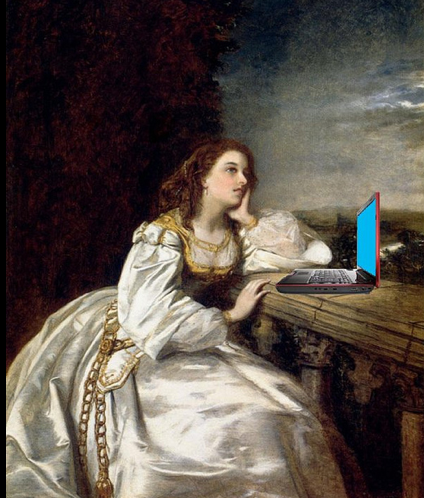
Image via Flickr Creative Commons, courtesy of Mike Licht
In the era before the Impressionist artists we now adore so much, artists could only live (survive) by being commissioned by wealthy patrons. Unlike today, paintings and images were extraordinarily rare. A human could live out an entire lifetime without ever seeing a painting.
Most regular people only saw paintings/images in churches or cathedrals. Visual art was planted almost exclusively within the realms of royalty and the very wealthy.
Thus, if an artist wanted to be PAID, he would paint what consumers wanted. Portraits were super popular (since Selflies hadn’t yet been invented). Artists would paint grand horses, breathtaking and realistic landscapes, religious pieces, etc. Why? Because YES it was art, but it was art that made money.
The Impressionists who are now so famous were actually very revolutionary, and at times? Extremely unpopular, ridiculed, and destitute. Though classically trained under the masters of the time, they wanted something fresh…different.
Thus, artists like Monet, Renoir, etc. began playing with color and light. Instead of something so realistic it might be a vision witnessed in person, they sought the haze of unreality, perhaps the look of lilies floating on water in a dream instead of life.
Another CRAZY notion these rabble-rousers had was to paint things that were very ordinary—women washing clothes in a river, landscapes of the docks with ships unloading wares, a peasant girl guiding geese along a path.
THE HORROR! Who would want to look at these fuzzy images of peasants and docks and REGULAR PEOPLE?
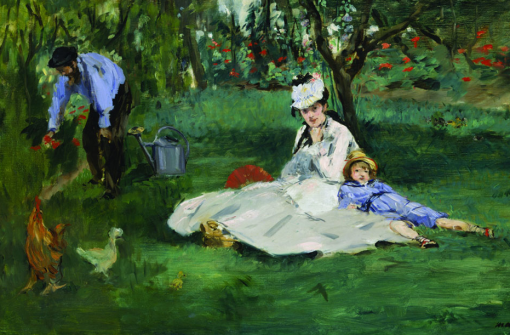
Manet 1874 via Wikimedia Commons
Well, apparently a lot of people, just not immediately.
Artists back then aren’t so different than today. If we want a “surer” bet for making money? We write what people want. The trick, though (especially for The Digital Age Author) is to write what people don’t yet KNOW they want.
We’ll talk more about that later.
Learning “Rules”
Picasso painted in the accepted classical style before he reinvented art as people knew it (and if one studies his work, it is clear he built in Impressionism and Post-Impressionism).
Hemingway learned how to write the “accepted” way (journalism) before he harnessed his training as a reporter and used it to strip fiction down to the bare form he’s now renowned for.
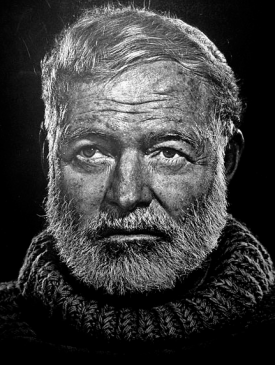
Image courtesy of Wikimedia Commons
Elvis sang in church before becoming the King of Rock ‘n’ Roll. Even Ludvig Von Beethoven broke rules. He continued to maintain the basic Classical traditions of form yet he infused much more melody, rhythm and harmony, thus stretching the musical “vocabulary” of competing composers of the time.
The point I’m making here is READ. Read craft books. Understand the basics and fundamentals so much they are a part of you, then? Have some fun. Break some rules.
We Take Rule-Breaking for Granted
Writing Forms and POV
The novels we now enjoy DID NOT exist until roughly the 18th century. Even then, we wouldn’t particularly recognize them or like them. But, then again, storytelling has been evolving for thousands of years.
Stories were originally communal story-telling, expressed around a campfire, committed to memory or a cave painting, and handed down orally.
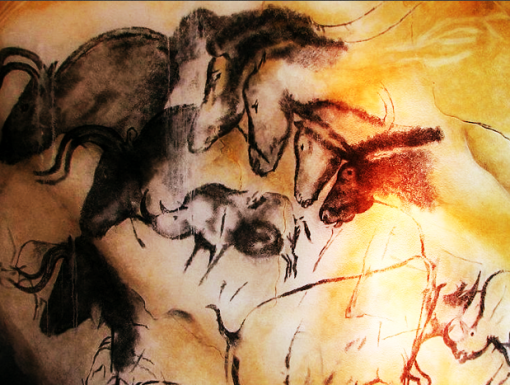
Image via Wikimedia Commons
Later, humanity experienced the rise of the epic poem (works like The Odyssey or even Beowulf). Fast-forward and lots of religious writing, including works like Paradise Lost or Dante’s Inferno.
Then we see an explosion of poetry, plays and the invention of sonnets (an Italian guy named Pertrarch) then later that version of the sonnet reinvented into the Shakespearian Sonnet, which includes three quatrains (set of four lines, every second line rhymes) and a closing couplet (set of two rhyming lines).
Shakespeare, that rebel.
But each generation learned what was HOT during their time, then built their own visions atop the old. Pamphlets, shorts, and serials were actually the precursors to the novel (think Sherlock Holmes).
If one reads early novels, psychic distance was VERY…distant. Almost everything was written in omniscient POV. In my opinion, this was reflective of the age. People didn’t travel. They waited months for letters. News of a war came often after the war was over and the dead buried. It took months or years to travel to distant places, and the world was very disconnected.
This is why many early novels are guided by a God-like narrator.

Come with me, Dear Reader….
Also, since many writers were paid by the word, novels were padded more than a freshman term paper (War and Peace). There was LENGTHY and tedious description because it was necessary. People didn’t have the kind of access to information we now take for granted.
People who had enough education to read and enough money for books also had A LOT more free time.
LONGER=BETTER
Additionally, the Image Revolution (brought about by the invention of film and photography) had yet to happen. Unless one spent a hundred pages describing a whale, no one (aside from those living on the coast) would know what the heck the writer was talking about.
This is also why we see authors like Mark Twain writing some characters’ dialogue in pure vernacular. Someone in England would have no clue what someone from Mississippi sounded like.
During the Industrial Revolution, we had an explosion of technology. Photographs, newspapers, telegraphs, trains, steamships, etc. connected humans more than ever, thus writers once again broke and rewrote rules. They began closing the psychic distance and leaving out now-common details.
In the 1800s third-person shifting hadn’t yet evolved. It wasn’t until radio, film, and later television accustomed audiences to shifting scenes that we see can the distinctive rise of third-person. First-person also became far more popular.
Because humans were more connected and closer, they wanted to be CLOSER to characters as well.
Writers like Hemingway stripped away the excess down to only necessary words. He broke rules of overwriting, believing that all the “superfluous” details took away from the essential human story.
As we progress into the 20th century, we see the rise of close-third. Today, close-third and first-person are very popular. Why? We are a Reality TV Generation. We’re spoiled with intimacy. Omniscient would feel alien and cold to many of us.
Breaking Rules of Genre
All early sci-fi, gothic, fantasy writers broke the rules of what people wanted to read. Like painters who no longer wanted to create works of reality, these authors dove into unreality. Jules Verne, Mary Shelley, Tolkien? All rule-breakers.
Genre, to be blunt, was invented by those who sold books. When physical books started appearing in bookSTORES, book SELLERS needed a way to know where the heck to shelve a story to help potential customers locate what they might want to read.
Genre was also highly political.
Horror was a VERY popular genre until the slasher films and gore-porn of the late 1970s and then the 1980s tainted the entire genre. Then we began to see horror “disappear” and labeled under other “genres.” “Supernatural” for instance.
****But, as an aside, gore-porn like Texas Chainsaw Massacre also broke rules. We were a nation reeling from Vietnam. The rules of horror before had been, “Wait until daylight and you’re safe.” TCM threw that away. We were NEVER safe EVER.
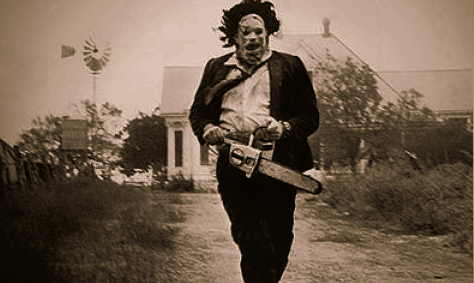
Texas Chainsaw Massacre
Speaking of breaking rules, I bet this is the first blog you’ve read that talks about Beethoven, Renoir, Hemingway AND Texas Chainsaw Massacre. :D
Moving on…
What to Do With The Digital Age
In The Digital Age, humans consume more information in a week than our early ancestors did in a lifetime. We are connected globally 24-7. We’re exposed to all kinds of ideas, information, myths, cultures, subcultures, etc.
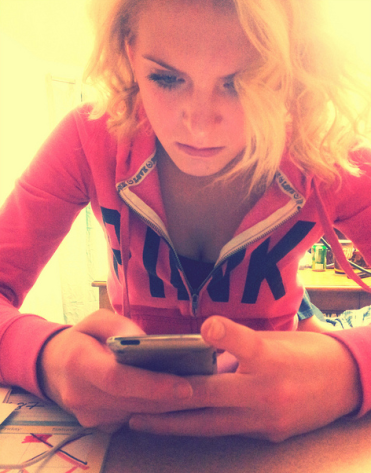
Image via Pink’s Galaxy Flickr Creative Commons
Strict genre is blurring as brick-and-mortar stores give way to digital bookshelves. Writers also have access to new audiences and emerging markets.
When we study the works of artists of before and even today, we can see areas where we might try something new. Since we are no longer chained to making it through Gatekeepers of NYC? We have a lot more freedom to be artists.
Now, I will say that breaking rules, while fun, has a price. People might not “get” it for a while. We need tough skin. We also need to make sure we are being artists and not amateurs. All art still has structural rules that need to be followed to maintain integrity. Rules are meant to be a foundation, not a straight-jacket.
For instance, architecture is art, but it must merge with rules of engineering or all we’re left with are pretty but deadly bridges, injuries, lawsuits, mold problems, and leaky, unsafe roofs.

The roof of Daniel Libeskind’s Westside Shopping Center in Bern, Switzerland has collapsed twice since its completion in 2008, the second failure injuring three people and narrowly missing a small child (refer to above hyperlink)…
Aesthetics are fabulous, but architects are commissioned to build a bridge that cars can safely traverse…not a billion-dollar sculpture. As writers, we produce books, so we must still have a story or we don’t have a book.
Next time, we’ll explore some more contemporary rebels and maybe even brainstorm some ideas about how we can reshape our art and bring fresh new ideas to our readers. We’ll even talk about the writing business, because business must also be creative and evolve or it will die.
Remember, if artists HADN’T broken rules, we’d all still be memorizing stories and painting on cave walls ;) .
What are your thoughts? What “artistic” rebels do you admire and why? Do you like it when a writer defies conventions and surprises you? What are some artistic ideas that have fallen flat and why? Did they confuse you? Bore you? Deviate too far? The ones you liked, what was different that intrigued you?
I LOVE hearing from you!
To prove it and show my love, for the month of JANUARY, everyone who leaves a comment I will put your name in a hat. If you comment and link back to my blog on your blog, you get your name in the hat twice. What do you win? The unvarnished truth from yours truly. I will pick a winner once a month and it will be a critique of the first 20 pages of your novel, or your query letter, or your synopsis (5 pages or less).
I will announce December’s winner later (probably next blog) when I have had some SLEEP.
For those who need help building a platform and keeping it SIMPLE, pick up a copy of my latest social media/branding book Rise of the Machines—Human Authors in a Digital World on AMAZON, iBooks, or Nook.

January 1, 2015
Want to Be a “Success”? Learn to Be an Outlaster

Original image courtesy of flowcomm, via Flickr Commons
Happy New Year! 2015 is now here and it is up to us what we will do with the time each of us is allotted. We all have heard the saying, “DaVinci had the same 7 days and 24 hours.” I would actually make a different point. Folks like DaVinci, Mozart, Shakespeare actually had LESS time.
There was no electric lighting and pulling all-nighters was a good way to go blind by candlelight. Thus, I’d say the difference is that these artists lived intentionally.
We all want to know the secret to “success.” First of all, I am going to add a caveat. “Success” is a very personal thing. What is “success” for you isn’t “success” for me. Yet, study after study shows that people who write down their goals are far more likely to reach them.
Why?
We have forced our minds to have a Mission Statement and our subconscious will use that to guide us. That is where the cool dreams and great ideas are born. Also, we are far more likely to recognize opportunity when we see it.
Living intentionally is vital because it allows us what I believe is one of the HUGE keys to reaching our dreams—learning to be an OUTLASTER.

Original image courtesy of Flickr Creatinve Commons, courtesy of Ali Samieivafa.
***I learned this term from minister and speaker Craig Groeschel and it has REALLY helped me.
We can take craft classes, join a gym, type on the WIP, start a blog, but the difference between those who make it and those who don’t is that those who make it KEPT GOING, even if it was just a tiny bit of effort daily.
Business
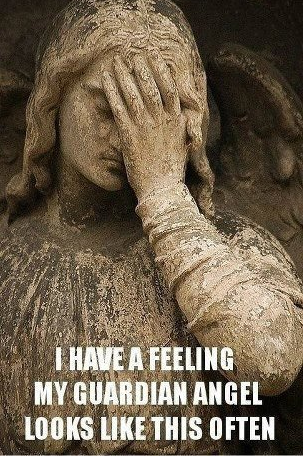
Actual image of Kristen’s Guardian Angel
I began W.A.N.A. International almost three years ago, and the business setbacks alone have been crushing. It is no easy feat to reinvent publishing and writing classes and conferences as we know them. W.A.N.A. was the first to have a GENUINE global writing conference (with a HUGE thanks to Tech Surgeons and Jay Donovan). We had real classes with NYTBSAs, agents, editors and attendees from all over the globe.
***W.A.N.A. stands for We Are Not Alone, btw.
And, though we enjoyed success, it came with a heavy price. It was one kick in the teeth after another. We were working with brand new technology, trying to schedule a conference that would accommodate everyone from New York to New Zealand. We also had legal battles, turnover, betrayals, LOCUSTS!
THANK GOD I had the great W.A.N.A. instructors by my side simply because they believed in what we are doing. And we are STILL HERE!
Blogging & Writing
When I started blogging, I was THRILLED to have 40 visits a day. Granted, most were spam bots, but hey! They counted, RIGHT? One of my close writing friends and I were talking about how many people used to blog regularly 5 years ago and almost all of them are no longer blogging.
Blogging is crucial for a brand and selling books. It is the STRONGEST and most resilient form of social media, yet most people give up.
I also have noticed how many people were SO passionate about writing, would do ANYTHING to publish and write full-time. Now? Most are gone. New people filled with the wonder and dreams have taken their place, but how long will they last?
***Refer to What Are the REAL Odds of Being a Successful Author?
Here’s the thing. Starting is easy (okay, “easier”). It is fresh and wonderful and emotional. Starting is CRUCIAL. There might even be all kinds of people to cheer you on.
But how will you fare when the new wears off and those who pledged undying support and loyalty move on to a new shiny because we weren’t an overnight success?
The key to making it in ANYTHING from writing to business to marriage to losing weight is to become an OUTLASTER.
Traits of an Outlaster

Original image via Lucy Downey from Flickr Creative Commons
Outlasters have clear and achievable goals.
Notice I didn’t say realistic goals. Reach for the stars and we may hit the moon. BUT, my goal to be a NYTBSA is realistic because I am a writer. If I have a goal to become a high-fashion model? Um, at a fluffy 5’3″ and 40 years old? Uh…NO.
Outlasters write down goals and have CLEAR Mission Statements.
The Mission Statement keeps us focused. We learn where to say yes and where and when to say no.
If my goal is to become a NYTBSA in the next five years, I know it is unwise to volunteer for every church event, school event, and family drama need. It becomes clear that I need to set word count based off MY goals. My word count will be very different if I want to write ONE book a year versus THREE.
Three sayings I kept with me from my days in sales?
Plan your work and work your plan.
Fail to plan and plan to fail.
Coffee is for Closers.
Outlasters understand the power of letting go.
Yes, Outlasters MUST hold on, hold on for LIFE! But to the right things.
Often letting go is more important than holding fast. This can involve letting go of hobbies, hangups and habits or even WIPs that just need to be put to bed. But the toughest? Letting go of people.
The best analogy I can think of for this is climbing Everest. If we want to climb Everest, there are teams of sherpas that guide you to the first base camp. As you go to each higher level, the team gets smaller and this is necessary.
Not everyone in our life is meant for the summit. Some could even get us killed.
I’ve had some SERIOUS issues with this. A writer I spent many years mentoring was caught on-line wholesale plagiarizing, and giving ME credit for his WONDERFUL work. This was a HARD blow to my brand and thank goodness kind people sided with me and realized HIS inexcusable behavior didn’t reflect MY character.
But, my brand was far smaller at the time. What if this happened later, when the damage could have been catastrophic? Sometimes the only thing we can be grateful for amidst the pain is TIMING.
We will mourn people we need to let go of, but often this is a good thing. We WANT the friends who believe in us even when all outside evidence says we are a failure. We never know who our real friends are when life is all kittens and unicorns. We find them (and they reach for us) in the darkness.
Outlasters Know NOTHING is WASTED
2014 was a HORRIBLE, HORRIBLE year. I had to back off everything because we had so many family members die or become critically ill. Right after this past Thanksgiving, both my grandparents (who raised me) were sent to the ICU on the same day. I just got off the phone from that news and received a call five minutes later that my aunt died. This was also after four months of debilitating Shingles.
I’ve done my share of grieving, of feeling badly about what I needed to do, should do, and beating myself up. But that isn’t productive. This past year, I’ve not been the Kristen Lighting the World on Fire and yet? Most of you stayed. New people joined.
This taught me that I not only could be the light for YOU, but that y’all could also be the light for ME.
I learned the value of rest. I backed off and slept (A LOT) to remove myself from the fray and really see where my priorities needed to be. Sometimes we get so caught in the artillery fire of life that we lose our bearings.
But that lost job or lost friend? That sickness or setback might just be a gift in hiding. We choose. What can this terrible event or mistake TEACH us?
Failures can be tombstones of stepping stones. Our choice.
Outlasters WORK
Luck is fabulous and would LUV me some luck. But I still believe the harder I work, the luckier I get. This said, working smarter is key. Sure, feel free to handmade all your clothes, but running to Target for new t-shirts might be a better use of time if your goal is to be a pro writer instead of a clothing designer.
There are no shortcuts. We MUST endure. And endurance can be small. It can mean we are so ill we can’t see straight, but we post a couple things on Facebook or ask a friend to guest blog…then go back to sleep. It is the small deposits and investments that accumulate over time.
But we write that book, remove that debt, lose that weight little by little. That’s what endures. Fad diets and quick fixes don’t change our character. Just like eating well and exercise should be a lifestyle, being a writer is a WHOLE new way of living. It isn’t a hobby or a thing or our little fun…it is who we ARE. Writers WRITE.
Outlasters Understand the Long-Tail
If we look at life day by day we will get discouraged. It’s kind of like going back to the gym and then getting on the scale every hour to see what’s changed. Formula for a breakdown. Outlasters just keep writing, keep failing, keep learning, keep trying and they do it over and over and over and over.
Outlasters CANNOT Succeed Alone
Part of why I created the W.A.N.A. Community is that we are who we hang around. Show me your closest friends and I’ll show you your future. We need a team, especially in The Digital Age. There is simply too much to learn or know.
Too many predators who see dollar signs over the newbie writer’s head. Conversely, there are a LOT of great people in the industry and your connections can save you time and guide you.
Find positive, professional, driven people and you WILL come up higher. Psychic vampires, whiners and complainers need to GO. Take inventory and seek out those you admire. Study them. Listen and learn from them. This is a tough road, but no one ever said we had to do it alone.
We all fall, bump our noses and bloody our knees. That is GOOD. Keep pressing. You got this ;) .
So what are your plans for the New Year? Are you working on valuing baby steps? Reframing setbacks? Letting go of bad habits or toxic people? Any tips you might want to offer?
I love hearing from you!
To prove it and show my love, for the month of JANUARY, everyone who leaves a comment I will put your name in a hat. If you comment and link back to my blog on your blog, you get your name in the hat twice. What do you win? The unvarnished truth from yours truly. I will pick a winner once a month and it will be a critique of the first 20 pages of your novel, or your query letter, or your synopsis (5 pages or less).
I will announce December’s winner later in the week when I have had some SLEEP.
For those who need help building a platform and keeping it SIMPLE, pick up a copy of my latest social media/branding book Rise of the Machines—Human Authors in a Digital World on AMAZON, iBooks, or Nook.

December 26, 2014
Make Readers Suffer—Great Fiction Goes for the GUTS

Image courtesy of Reuters.
I hope everyone had a FABULOUS Christmas and is enjoying this wonderful time of the year. Holidays bring family and friends together and usually? This equals CONFLICT. Use it. Eavesdrop. Great writers make a MESS because that is what is the heart of the best stories. The uglier the better. You will one day be grateful for that seriously jacked up childhood.
Sally forth!
I think it’s fair to say that writing a novel is no easy task. There is a lot to balance at the same time—narrative, setting, dialogue, POV, plot points, turning points, scenes, sequels, character arc, etc. It can be very challenging for even the best of us. Yet, I believe the hardest part of writing fiction is that, for most of us who aren’t crazy, conflict is something we avoid at all costs during our daily lives.
In fiction? We must go for the guts.
Today, I’d like to offer you a simple way to make your stories and characters three-dimensional and grab hold of great fiction’s throbbing heart. I learned this from the fabulous Les Edgerton who cornered me with this same question:
What is your character’s true story problem?
I gave Les a rundown of my carefully researched mystery thriller and he pressed again.
That’s surface, Kristen. What is the real story problem?
Fortunately, I was able to answer the question. Aside from the embezzlement, fraud, gun-running and drug-dealing, my character’s problem is she longs to be accepted, yet doesn’t fit in anywhere.
She began as small town trailer trash and ran away from home to go to college and pursue a better life. She naively assumed a fancy college degree would be her keys to acceptance, her ticket to become part of the high-class society she’d always envied. Yet, once she “made it” she found herself worse off than before. No matter how hard she worked, she was still, in the eyes of high society, gold-digging trailer trash who didn’t know her place.
In one world (home) she’s regarded as an uppity b!#$@ too good to be blue-collar working class. Yet, once part of “society” her problem was just as bad. The rich assume she must have slept her way into her high-paying job and that her sole goal is to marry money. She soon finds she’s regarded with equal disdain.
The story problem (the mystery) is only there to answer my protagonist’s deep, driving personal questions: Where do I fit in? Why do I need to fit in? Who am I?
The plot problem—a major embezzlement (Enron-style) leaves her penniless and blackballed and she has to go home to the trailer park she thought she’d left for good. This is where the story begins.
Now she is forced back into the lion’s den of her soul. Now she is torn between worlds. To solve the mystery and find the missing money (and a murderer killing to keep the secret) she must take on the wealthy and powerful. But in order to succeed, she must rely on a crazy-dysfunctional family who resents her and feels betrayed and judged.
Eventually, the plot will force her to face her greatest weakness—the need to be accepted—and she will have to make the tough choices.
If we look to all the great stories, the questions are bigger than the story. Minority Report has all kinds of cool technology, but the big question is, “Are we predestined, bound by FATE, or do humans possess free will?” In The Joy Luck Club the question is, “Can generational curses be broken?” In Winter’s Bone “Is blood really thicker than water?” In Mystic River “What is the nature of good and evil? Are people really who they appear to be?”
Thus, I challenge you to pan back from your story and ask What is the BIG question here? What is my character REALLY after? What will my story problem CHANGE about this character? What will it answer?
As you guys know, I run a regular contest for free edit of sample pages. One of the biggest issues I see in new writing is it is very surface (Hey, I’ve been there, too. It’s all part of the learning curve ;)). Yet, to take that writing to the next level, we have to dig into the dark and dirty places. I actually have a sticky note on my computer that reads GO FOR THE GUTS.
Every scene, every bit of dialogue must be uncomfortable. Fiction is the opposite of our human nature. Human nature is to avoid conflict at all costs. To write fiction? We must dive into the Miserable Messy head-first. Create problems at every turn (not mere “bad situations” but conflict).
Conflict turns pages. We have to be careful that our dialogue isn’t so busy being clever that it loses it’s teeth. Pretty description and scene-setting doesn’t turn pages and hook readers. CONFLICT does. Humans have a need to avoid conflict, but when we are faced with it? We want it resolved. THAT is why readers will turn pages. We make them shift in their seats and squirm and seek resolution.
What are your thoughts? What movies can you think of that have amazing BIG questions? Do you find that you have to revise places you are being “too nice?”
I love hearing from you!
To prove it and show my love, for the month of DECEMBER, everyone who leaves a comment I will put your name in a hat. If you comment and link back to my blog on your blog, you get your name in the hat twice. What do you win? The unvarnished truth from yours truly. I will pick a winner once a month and it will be a critique of the first 20 pages of your novel, or your query letter, or your synopsis (5 pages or less).
For those who need help building a platform and keeping it SIMPLE, pick up a copy of my latest social media/branding book Rise of the Machines—Human Authors in a Digital World on AMAZON, iBooks, or Nook.

December 18, 2014
Caveat Venditor—Five Mistakes KILLING Self-Published Authors
All right, it’s about to be a brand new year and many of you are wanting to finally see your books published. ROCK ON! But, I am the friend who will tell you if there is toilet paper hanging out of your pants. Writing isn’t all glitter and unicorns and I want to warn you of the most common stumbling blocks, because I really DO want you to succeed.
When I began writing I was SO SURE agents would be fighting over my manuscript. Yeah. But after almost fourteen years in the industry, a lot of bloody noses, and even more lessons in humility, I hope that these tips will help you.
Self-publishing is AWESOME, and it’s a better fit for certain personalities and even content (um, social media?), but we must be educated before we publish. In fact, my last book Rise of the Machines (cover above) is much more than a social media book. I dedicate a large portion of the book explaining how the various forms of publishing work, because you need to make the best choice for YOU.
I want that decision to be an EDUCATED decision.
Moving on….
Mistake #1 Publishing Before We Are Ready
The problem with the ease of self-publishing is that it is, well, too easy. When we are new, frankly, most of us are too dumb to know what we don’t know. Just because we made As in English, does not automatically qualify us to write a work spanning 60,000-100,000 words. I cannot count how many writers I’ve met who refuse to read fiction, refuse to read craft books, and who only go to pitch agents when they attend conferences at the expense of attending the craft sessions.
Additionally, too many new writers I meet do not properly understand the antagonist. They don’t grasp three-act structure, and most don’t have any idea what I mean when I mention POV, Jungian archetypes, or the phrase, “scene and sequel.”
I see a lot of new writers who believe their story is the exception, that the rules make for “formulaic” writing. No, rules are there for a reason, and, if the writing is too formulaic, it has more to do with execution than the rules.
****And YES, we can and SHOULD break rules but that is another post. Every musician has to learn to play the instrument before reinventing music as we know it.*****
Three-act structure has been around since Aristotle, and there is a lot of evidence in neuroscience that suggests that three-act structure is actually hard-wired into the human brain. Thus, when we deviate too far from three-act structure, it confuses and frustrates readers.
Stories have clear beginnings, middles and ends. Without a clear story objective, it is impossible to generate dramatic tension, and what is left over is drama’s inbred cousin, melodrama. Yet, many writers start off writing a book without properly understanding the basic skeleton of story.
Heck, I didn’t and I deserved every rejection I got…
Writing fiction is therapeutic, but it isn’t therapy. Yes, characters should struggle with inner demons, but that does not a plot make. Struggling with weakness, inner demons, insecurity, addictions are all character arc, not plot arc. There should be a core story problem that we can articulate in ONE sentence. The plot arc should serve to drive the character arc. If the character does not grow and change she will fail, but it is the core story problem that drives this change.
No problem, no crucible.
Yes, we are artists, but we need to understand the fundamentals. I played clarinet for years, and yes it was an art. But this didn’t excuse me from having to learn to read music, the finger positions and proper embouchure (the way to position the mouth to play).
The better we are at the basics, the better we know the rules, the more we become true artists.
I’ve received contest winners whose first pages were filled with newbie errors. Yet, when I sent them my critique filled with pages of corrections, I would then receive a reply telling me that the book had already been self-published.
OUCH.
Sometimes there are reasons we are being rejected and we need to take a hard look and be honest. Self-publishing is suffering a stigma from too many writers publishing before they are ready. If you really want to self-publish, I am here to support you and cheer you all the way. Heck, I did it. Will probably do it again.
But remember, though the stigma IS fading we have to write better than the traditional authors.
Mistake #2 Jumping in Before Understanding the Business Side to the Business
I see a lot of writers rushing into self-publishing without properly preparing to be a small business, yet that is exactly what we are. When we self-publish, we take on new roles and we need to understand them. We need to be willing to fork out money for proper editing, cover design and formatting.
One of the benefits to traditional publishing is they take on all the risk and do the editing, proofing, etc. When we go it alone, we need to prepare for some expenses and do our research.
We can be told a million times to not judge a book by its cover, yet that is exactly what readers do. Additionally, we may need to look into becoming an LLC. We need to set up proper accounting procedures and withhold the correct amount of taxes, unemployment, state taxes and on and on.
Mistake #3 Believing that, “If We Write it They Will Come”
There are a lot of writers who mistakenly believe that self-publishing is an easier and faster way to fame and success. Yeah, um no. And those magic beans are really just beans. Sorry.
Self-publishing is A LOT of work, especially if we are starting out this way. If you didn’t defect from traditional publishing and can’t slap New York Times Best-Selling in front of your name? Prepare for a ton of work.
Not only do we need to write good books, but we need to write prolifically. When we self-publish, we need a much larger platform because we don’t have New York in our corner. This is one of the reasons self-publishing isn’t for everyone. We need to look at how badly we want the dream, and then ask how many hours are we willing to work? What are we willing to sacrifice?

Image from the movie “Office Space”
Mistake #4 Misusing FREE!
There are a lot of problems with giving books away for FREE! We shouldn’t be giving away our work unless it serves some kind of a strategic advantage. There are ways to effectively harness the power of FREE! but too few writers understand how to do this and they just end up giving away their art for no tangible gain. This goes with my above point of us needing to understand the business side of our business. When we do choose to give away stuff for FREE! it needs to serve longer-term business goals.
Mistake #5 Shopping One Book to DEATH
One of the BIGGEST problems I see with self-published writers is that they publish one book and then they focus every bit of energy on selling THAT book.
They fill up all the writing hashtags with link spam promoting their books. They keep futzing with the cover, the web site, the promotions. They do blog tours until they drop, and they do everything except what is going to help that book sell a ton of copies…write more books.
Here’s the thing. Self-publishing, in many ways, just allows us to accelerate the career path of the author. Even in traditional publishing, it usually takes about three books to gain traction. In traditional publishing, this takes three years because we are dealing with a publisher’s schedule.
In self-publishing, we can make our own schedule, but it still takes THREE BOOKS MINIMUM. I know there are exceptions, but most self-published successes hit at about book three. The ability to offer multiple titles is a huge advantage.
Just make sure they are good books ;).
This is why it is critical to keep writing. Not only will writing more books make you a better writer, but once people discover they love your writing, they have a number of titles to purchase. Being able to offer multiple titles is how we make money at self-publishing. It also helps us maximize the whole FREE! tactic.
Even I am putting my nose to the grindstone to come out with more books in the next six months. I don’t tell you guys to do anything that, I myself, am unwilling to do. I have two books in a series already written, but I’ve made the decision not to give them to a publisher or publish myself until I have a minimum of THREE finished titles.
This is a profession, not a playpen.
Remember Why We Do This
Self-publishing is a wonderful alternative. Just because we self-publish doesn’t mean we cannot publish other ways, too. I’ve been saying this for a LONG time, but it bears repeating. I feel the author of the future will actually be a hybrid author, and I do believe that the ability to self-publish is challenging all of us to come up higher.
We are striving to be better writers, to be better entrepreneurs, to get better at organization and time-management and to write more books and better books. If we can learn from these mistakes and grow, then the future is ours for the taking.
A little humor from the fabulous David Kazzle…
What have been some of your challenges with self-publishing? In what areas is it forcing you to grow? Have you had to outsource? What sacrifices have you made? Tell us your story!
I love hearing from you!
To prove it and show my love, for the month of DECEMBER, everyone who leaves a comment I will put your name in a hat. If you comment and link back to my blog on your blog, you get your name in the hat twice. What do you win? The unvarnished truth from yours truly. I will pick a winner once a month and it will be a critique of the first 20 pages of your novel, or your query letter, or your synopsis (5 pages or less).
For those who need help building a platform and keeping it SIMPLE, pick up a copy of my latest social media/branding book Rise of the Machines—Human Authors in a Digital World on AMAZON, iBooks, or Nook.

December 16, 2014
What Are the REAL Odds of Being a Successful Author?

Image via Flikr Creative Commons Hakan Dalstrom
I didn’t even consider becoming a writer until 1999 after my father passed away suddenly. Funny how death can make us take a hard look at life, right? Anyway, I recall feeling soooo overwhelmed. I mean my odds of even getting published were about as good as winning the lottery. And the odds of becoming a best-selling author? Well, mathematically speaking, I had a slightly greater chance of being mauled by a black bear and polar bear on the same day.
It was all I could do not to give up before I began.
But, after over 14 years doing this “writer thing,” I have a new perspective. Often it feels like we are the victims of fate, at the mercy of the universe, when actually it is pretty shocking how much of our own destiny we control. The good news is that if we can get in a habit of making good choices, it is staggering how certain habits can tip the odds of success in our favor.
Time to take a REAL look at our odds of success. Just so you know, this is highly unscientific, but I still think it will paint a pretty accurate picture. I will show you a bit of my own journey. And, to be blunt, this DOES NOT ONLY APPLY TO WRITERS.
Did you know most entrepreneurs fail at least three times before getting traction? Most new businesses don’t make it a year. They are fortunate to survive THREE years and if they can hit The Golden Six? Smoother from there. But WHY?
The 5% Rule
It has been statistically demonstrated that only 5% of any population is capable of sustained change.
I remember when I was a rather young writer and NYTBSA Bob Mayer introduced me to this idea. I was AGHAST! No, writers just needed nurturing, cuddling, and help. Trust me, it pains me to say he was/is right.
***But Bob is generally right and that is often why it ticks me off to admit this.***
I worked for years with self-professed writers who refused to learn, listen or even work. They had the skin of a grape and wanted to make it in an often undervalued profession that is NO place for the idle or thin-skinned.
Thus, with that in mind…
When we start out wanting to write, we are up against presumably millions of other people who want the same dream. We very literally have better odds of being elected to Congress than hitting the NY Times best-selling list. But I think that statement is biased and doesn’t take into account the choices we make.
As I just said, in the beginning, we are up against presumably millions of others who desire to write. Yes, millions. It is estimated that over ¾ of Americans say that they would one day like to write a book. And that is only ONE continent. Much of Europe, Australia and New Zealand are burgeoning markets in the new digital paradigm.
That’s a LOT of people. Ah, but how many do? How many decide to look beyond that day job? How many dare to take that next step?
Statistically? 5%
So only 5% of the millions of people who desire to write will ever even take the notion seriously. This brings us to the hundreds of thousands. But of the hundreds of thousands, how many who start writing a book will actually FINISH a book? How many will be able to take their dream seriously enough to lay boundaries for friends and family and hold themselves to a self-imposed deadline?
Statistically? 5%
Of that 5%, how many will join a critique group—A GOOD ONE—and learn instead of sulking?
5%
Okay, well now we are down to the tens of thousands. Looking a bit better. But, finishing a book isn’t all that is required. We have to be able to write a book that is publishable and meets industry/reader standards. When I first started writing, I thought that everyone who attended a writing critique group would be published. I mean they were saying they wanted to be best-selling authors.
But did they?
Or, were they more in love with the idea of being a best-selling author than actually doing whatever it took to succeed? I would love to say that I was a doer and not a talker, but I don’t want to get hit by lightning. There were a number of years that I grew very comfortable with being in a writing group as a writer…but not necessarily a professional writer.
I was still querying the same book that had been rejected time and time and time again. I wrote when I felt inspired and didn’t approach my craft like a professional. I was, at best, a hobbyist and, at worst, hopelessly delusional.
I didn’t need craft books *snort* I spoke English, so I knew how to write. Geesh! *rolls eyes*
I was a member of two writing groups, and had grown very fond of this “writer life.” We hung out at I-Hop and drank lots of coffee. We’d all chat about what we’d do with our millions once we were bigger than Dan Brown. We talked about new ideas for books that never seemed to get written. Or if we ever did sit to write one of these ideas, we would get about 30,000 words in and then hit a wall.
Hmmm…and I thought that idea had so much promise.
Yet, after four years hearing the same talk from the same people shopping the same novels, I had a rude awakening. Maybe I didn’t know as much as I thought I knew. Maybe being a copy writer and technical writer and editor didn’t automatically make me a novel-writing genius. Maybe I needed to take this dream of being a best-selling writer a tad more seriously and not rely on bluster, BS and glitter. Maybe I needed to read craft books and scrape up enough money to go to a conference.
So, of the tens of thousands of writers who write a novel, how many read craft books and get serious enough to take classes, listen to thoughtful critique, and attend conferences?
You guys are good….5%
And of those who attend a conference (and want to traditionally publish), who are asked to send in page requests, how many follow through?
Likely, 5%
How many will land an agent right away?
5%
And of all of those authors rejected, how many writers, determined to impress, are willing to GUT their novel and wage wholesale slaughter on entire villages of Little Darlings? How many are willing to put that first novel in a drawer, learn from the experience and move forward with a new book…which they FINISH?
5%
And of the writers who land an agent or are brave enough to go indie or self-publish, how many of them get dead-serious about building a large social media platform?
Again? Probably 5%.
And of those writers who are published and doing social media, how many of them are effectively branding their names so their name alone will become a bankable asset (versus taking the easy way and spamming everyone in sight)?
5%
Of those who self-publish, how many will keep writing more books and better books until they hit a tipping point for success? (versus beating marketing one book to death)
5%
Of writers who self-publish, how many will invest in professional editing and cover art?
5%
Thus, when we really put this dream under some scrutiny, it is shocking to see all the different legs we control.
We control:
Taking the Decision Seriously
Writing the Book
Editing the Book
Finishing the Book
Learning the Craft
Developing RHINO SKIN
Networking
Following Through
Not Giving Up in the Face of Rejection
Writing Books
Writing More Books
Yes, Writing Even MORE Books
Doing Everything in Our Power to Lay a Foundation for a Successful Career
I am not saying that finishing a book is easy. None of this is easy.
This job is a lot of hard work and sacrifice, which is exactly why most people will never be genuine competition. When we start out and see all the millions of other writers I think we are in danger of giving up or getting overwhelmed. Actually, if we focus on the decisions we control, our odds improve drastically.
This job is like one giant funnel. Toss in a few million people with a dream and only a handful will shake out at the end. Is it because fortune smiled on them? A few, yes. But, for most, the harder they worked, the “luckier” they got. They stuck it out and made the tough choices.
In the Sahara there is a particularly long stretch of desert that is completely flat. There are no distinguishing landmarks and it is very easy to get lost. To combat the problem, the French Foreign Legion placed large black oil drums every mile so that travelers could find their way across this massive expanse of wasteland one oil drum at a time.

Are we there yet?
Want to be a successful author?
Take it one oil drum at a time.
What are some oil drums you now see ahead? Does your journey to author success seem easier now? What makes you feel overwhelmed? What inspires you?
And some HOLIDAY fun with KRISTEN LAMB!
I love hearing from you!
To prove it and show my love, for the month of DECEMBER, everyone who leaves a comment I will put your name in a hat. If you comment and link back to my blog on your blog, you get your name in the hat twice. What do you win? The unvarnished truth from yours truly. I will pick a winner once a month and it will be a critique of the first 20 pages of your novel, or your query letter, or your synopsis (5 pages or less).
For those who need help building a platform and keeping it SIMPLE, pick up a copy of my latest social media/branding book Rise of the Machines—Human Authors in a Digital World on AMAZON, iBooks, or Nook.

December 12, 2014
Why Are Certain Stories Timeless? What Scrooge Can Teach Us About Great Writing
One of my all-time favorite movies for the holidays is The Muppets Christmas Carol. I believe I’ve seen this movie a few hundred thousand times. I’ve worn out three VHS tapes and at least three DVDs. I play the movie over and over, mainly because, well, duh, MUPPETS! I drive my husband nuts playing this movie over and over…and over.
I’m worse than a three-year-old.
Muppets aside, I also can’t get enough of the music. I love the story of A Christmas Carol no matter how many times I see it, no matter how many renditions, and I am certainly not alone. Charles Dickens’ story of a redeemed miser is a staple for holiday celebrations around the world and across the generations.
This story is virtually synonymous with “Christmas,” but why is it such a powerful story? Why has it spoken so deeply to so many? Why is it a story that never grows old? Today, I want to talk about a couple of the elements that speak to me, because they rest at the heart of great writing.
A Little Background
A Christmas Carol is a beautiful story, but I find it’s true beauty when it’s explained in the Christian context that inspired it. My son was watching Bubble Guppies and they tried (dismally) to tell the same story inserting “holiday” so as not to offend anyone, I presume.
Yet, the story fell flat.
The PC had ruined the beauty of this tale and made it more of a lesson about embracing shallow commercialism once a year than a story of love’s power to redeem the irredeemable. Thus, this post will use scriptural and religious references to explain why I believe this story is so moving and timeless.
The Power of Names
Naming characters can be vital. Great writers use the power of parsimony. Each element should serve as many purposes as possible. A name is more than a name. It has the power to be a story within a story.
I recall the moment I was first introduced to what would become my favorite hymn, Come Thou Fount of Many Blessings. One verse stood out:
Here I raise my Ebenezer
Here by Thy great help I’ve come
And I hope, by Thy good pleasure
Safely to arrive at home.
Ebenezer? Raise an Ebenezer? I needed to know more. Ebenezer is actually אבן העזר, Even Ha’Ezer, which literally means stone of help or monument to God’s glory and is referenced in the book of Samuel.
Thus, when Dickens chose a name for his protagonist, he chose the perfect name for the redeemed sinner. What is a better testament to a God of grace, than the hardened heart melted by the power of love? The current climate of political correctness aside, A Christmas Carol is most definitively a Christian story and the theme is reminiscent of Proverbs 25:22:
If your enemy is hungry, give him bread to eat
and if he is thirsty give him water to drink
for you will heap burning coals on his head
and the Lord will reward you.
Very often this verse is misunderstood. “Yeah! BURN ‘EM! THAT’LL TEACH THEM TO MESS WITH ME! COALS! BURN BABY BUUUURN!” Yet, if one looks to the ancient Hebrew, the heaping burning coals is literally the holy fire of LOVE that melts the hardened heart so it can be remade (think of melting a weapon of war to remake it into something of beauty or a tool for healing or farming).
The path to redemption is love, for only love holds the power to redeem those who have committed grave wrongdoings. Only love can repair what’s been broken and “remake” it into something entirely new.
The Christian story is a story of love, of redemption, of second chances and not because one has earned it or deserved it. Scrooge is a dreadful man, yet as the story unfolds, not only does Scrooge’s heart begin to melt as he’s faced with the truth of who he is, but our hearts melt toward Scrooge as we travel through the past, present and future and see what has created such a embittered, cruel person. We empathize and start to have compassion and love the unlovely.
Scrooge has done nothing to earn redemption, but his redemption is precisely why we cheer at the end.
The spectral visits serve to show Scrooge the truth, which again is reminiscent of scripture; and then you will know the truth and it is the truth that will set you free (John 8:32). Scrooge cannot change what he cannot see and it is the three ghosts who come to reveal what he’s failed to see on his own.
Repentance is not the mumbled and counterfeit “Sorry.” Rather, it is finally seeing the truth of who we are and what wrong we’ve done. It’s a decision to make things right and turn away from wrong.
By the end of the story, Ebenezer is truly repentant. He’s a changed person determined to share the love and grace that was freely given to him when he didn’t deserve it.
Again, what a wonderful testament to God’s love. What a lovely “Ebenezer.”
Jacob Marley is another symbolic name. Jacob Marley is the name of Scrooge’s old business partner, and it is he who intervenes to try and redeem his old friend before Ebenezer is sentenced to share Marley’s fate. The name “Jacob” actually means “thief and liar.”
In the Bible, Jacob stole his brother Esau’s blessing, then manipulated, lied, stole and connived until it came back to bite him multiple times (Jacob later wrestled with an angel until he could be given a new name, Israel and he’d become the father of a great people). What better name to give someone sentenced to roam as a specter for eternity carrying the weight of his ill deeds than a name that literally means thief and liar?
The Power of Symbol
When the ghost of Jacob Marley visits Scrooge:
The chain he drew about his waist was clasped about his middle. It was long and wound about him like a tail; and it was made (for Scrooge observed it closely) of cash-boxes, keys, padlocks, ledgers, deeds, and heavy purses wrought in steel…
Why cash-boxes? Why deeds? Why purses? In life Jacob was a money-lender. He was ruthless in his dealings and never forgave a debt. Yet, Matthew 6:12 (part of The Lord’s prayer) reads: Forgive us our debts as we have also forgiven our debtors.
Jacob forged his chains in life. He refused to show mercy, compassion, or kindness. He was ruthless and legalistic, thus he has sealed his fate. God has promised to forgive us the same way we forgive others, which is why the scripture pleads for grace, compassion and mercy. Also, forgiveness of debts is the heart of what Christmas is about, for unto us a child is born.
Christians believe God sent His only begotten son (God in the form of Man) to pay a debt we cannot hope to pay. God loves us as His children, and our actions have left us hopelessly out off our depth, incapable of paying our debts. Yet Love cancels the debt. Christ’s last words on the cross, “It is finished” literally translate “Paid in FULL.” Jacob turned away from the grace freely offered, so now he wanders, burden by the debts he cannot pay.
Jacob now finds opportunity to warn Scrooge of the chains he is now forging with his actions (and inaction), chains that are longer and heavier than even his. The only way for Scrooge to free himself is to learn to value himself and his fellow human beings.
Smaller Truths Reveal Larger Truths
Dickens makes it a point to show us that Scrooge is a miser. Scrooge shows no mercy, has no warmth, shares none of his wealth…with anyone, including himself. Scrooge is a very wealthy man, yet he wears old clothes, lights no coals for warmth because coal costs money. His home is threadbare and his food measly and meager.
The full story of redemption is that Scrooge not only sees his fellow man differently—worthy of compassion, love and generosity—but in changing how he views his fellow man, his view of himself changes (and heals) as well. The three spirits not only heal Scrooge’s relationship with his Maker, but with himself and others. Scrooge, for the first time, becomes part of the human experience, no longer content to be “solitary as an oyster.”
The POWER of WORDS
This point should resonate particularly with writers. There is a REASON the Ghost of Christmas Future refuses to speak. Words have creative power. If one looks at the first chapters of Genesis, God created the heavens and the earth and all living things by speaking. “And God said…”
It was only humans he breathed life into. Everything else was created by speaking. Throughout the Old and New Testament, there are countless scriptures referencing the power of the tongue, of words, and warning they carry both the power of life and death.
This idea carries into Ebenezer’s story because, by the time he has this final visit, he still has choice over what his future will be. The specter cannot speak because words would cast his future and it isn’t for the Spirit of Christmas Future to decide.
Happy Ending
Scrooge deserves the death he’s shown by the Spirit of Christmas Future. He deserves to die alone with those “closest” casting lots for his garments. This is what he has sown with his lifetime of greed, hate and spite.
Yet, he is pardoned.
Scrooge is the resurrected heart, the dead brought to life. When God promises “everlasting life” it isn’t a promise that we get to float around on a cloud in Heaven after we die. Rather, it’s a promise that life begins at the moment we decide to accept mercy and love.
Scrooge has been “alive” but not “living.” He was existing. When he is redeemed, given a new chance, he changes. Out of gratitude for the mercy he is given, he reaches out to give what he’s been given. LOVE, MERCY, GENEROSITY.
Restoration
Sure, God could have rained down a miracle that healed Tiny Tim and landed Bob Cratchit a better job with a better boss, but Dickens saw God as a God in the business of finding and changing the lost, miserable and broken. Instead of giving the miracle to Cratchit and his family, God, instead, gives it to Scrooge, the least deserving of a miracle.
Why?
Because God is about working through people. Many of His miracles come from ordinary people performing extraordinary acts of kindness and sacrifice. By changing Scrooge, God could create a man who would become a benefactor. Cratchit has now a kind and generous boss, the community now had a passionate philanthropist, and Tiny Tim lives and the family thrived because one man’s heart could be melted.
It is no great feat to love the lovely. If you love only those who love you, what reward is there for that? Even corrupt tax collectors do that much (Matthew 5:46). This story is so powerful namely because it shows that every human has value and is worth and an opportunity for redemption. God is in the business of changing hearts, and Dickens wanted to show that. A Christmas Carol is a masterful exploration of the true nature of Christianity, what it should be, what it was meant to be. Love. Above all.
What is your favorite version of A Christmas Carol? What do you love about this story? What is your favorite part? I love The Muppet’s Christmas Carol (already told y’all that), but THIS is my FAVORITE part!
Also, here is my favorite hymn, Come Thou Fount of Every Blessing. I cry every time I hear this:
I love hearing from you!
To prove it and show my love, for the month of DECEMBER, everyone who leaves a comment I will put your name in a hat. If you comment and link back to my blog on your blog, you get your name in the hat twice. What do you win? The unvarnished truth from yours truly. I will pick a winner once a month and it will be a critique of the first 20 pages of your novel, or your query letter, or your synopsis (5 pages or less).
For those who need help building a platform and keeping it SIMPLE, pick up a copy of my latest social media/branding book Rise of the Machines—Human Authors in a Digital World on AMAZON, iBooks, or Nook.

December 8, 2014
Time is Precious—Are We Investing Wisely?
We always here that phrase about time. You know the one. “Well, we all have the same 24 hours.” DaVinci, Mozart, Newton, Elvis all had 24 hours. It’s true. Yet why is it some people seem to make so much of their time and others have little or nothing (or even negative fruits) to show for it?
Today might be an uncomfortable topic, but if it helps any, it makes me uncomfortable too.
I don’t know if any of you are like me. Your attitude is, “Instructions are for SISSIES.” So I pull the pieces out of the box and just intuitively put stuff where it goes. Being an ENFP, we love doing stuff by gut. It’s comfortable…until it’s uncomfortable.
Because when I get to the end and am ready to plug in that lamp-endtable combo? It wobbles. Ah, hell, and there are these extra parts. I just thought they were being sweet and giving me backup screws in case I lost a few in the carpet.
So I have three choices. 1) Deal with/ignore wobbly lamb that leans like the Tower of Pisa 2) take the sucker apart and THIS time read the *rolls eyes * instructions and START OVER 3) PAY someone else to do it.
When we fail to plan we plan to fail, and there will generally be three outcomes:
1. Subpar thing/situation we just deal with and cringe a little every time we see it.
2. Cost us MORE time.
3. Cost us TIME and then MONEY (to buy someone else’s time).
See, if we don’t appreciate time and how it works or doesn’t work, we can leave ourselves open to chance, pain, misery, rework, etc.
Now, there are no right and wrong answers here. Why? Because you aren’t me and I’m not you. We ALL have different lives, challenges, gifts, constraints and past experiences. We all want different things out of life.
Thus today, these are some broad strokes that I hope will help you in writing, but also in ALL areas of life, because we need to be balanced.
Balance

Having any FUN lately?
I’ve been the person who had a LOT of money. When I was 28 years old, I was in sales and made more money than any twenty-something should make.
But…
I drove an average of 2500 miles a week. I didn’t date, spent no time with family or on my spiritual or physical health and guess what? It cost me my job and nearly my life. I almost died from pneumonia. AND, because I had no friends, no support network, and no close relationships with family, no one was there to think to check on me (and I was too proud to ask).
Thank God for pesky mothers.
I recall lying on the couch unable to breathe and realizing that I’d invested SO MUCH TIME into being “successful” that I could die and the only way someone would know the pneumonia finally beat me would probably be a from neighbor reporting a bad smell to the manager.
Low, low, looooow place to be. But, in retrospect? The best place to be and the greatest gift I was ever given.
Only We Can LIVE Our Dreams
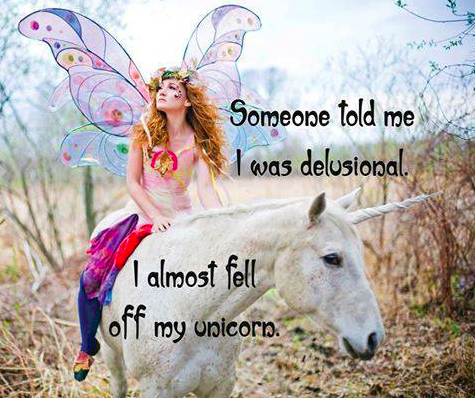
Image with Twig the Fairy
My father was brilliant. He wanted to be a writer, but instead he tried to fit into what family and culture said was “successful.” He died making $8 an hour fixing bicycles. Well, I didn’t want to be a “failure” like my father, so I took a job I hated because it provided the title, the car, the money, and the outward appearances of happiness.
Those of you who’ve read this blog for a while know I won an Air Force scholarship to become a doctor, because I thought it would impress my family. It didn’t. Then, I earned a premiere degree from a top university. Four people attended my graduation and I got a cake from a grocery store. So, I moved on to sales. If I made a LOT of money, surely they’d be proud. They weren’t. Then, I got into LAW SCHOOL.
Wait, do I even want to BE a lawyer?
Good thing for me the Brilliant Law School Plan came after the Near Death Experience with pneumonia. I wanted to be a writer, had known it since I was four, but I had to make others happy, right? I mean, when I said I was a writer they laughed, but if I had a LAW degree, that was writing….right?
And don’t get me wrong, I believe nothing is wasted in God’s economy. As a writer, I have used that three years as a Neuroscience major (the med school thing), and that degree in Political Economy of the Middle East and North Africa (the pre-law thing), and the many hard lessons from sales (namely that I SUCK at it).
But look at all the TIME, MONEY, and REVISION because I wasn’t brave enough to go after MY dream. Other people’s dreams cost us less, but also cost us everything.
Because my father wanted to be a writer and failed, being a writer=FAILURE. I never stopped to think he failed to plan so he planned to fail. Since I was spread all over the map trying to make everyone but me “happy” I had no focus. When it came to my end goal of being a NYTBSA, I had a LOT of lost time to make up for.
We CANNOT Have Everything
Time is finite. The media will tell us we can have six-pack abs, cook gourmet foods, have a Martha Stewart house, perfect kids and can be everything to everyone all the time.
WRONG.
We MUST choose. If we don’t, we will live the equivalent of the cheap All You Can Eat Buffet. Lots of choices, most that gets tossed away and never really satisfies (and might even make us sick).
When we realize we can’t HAVE everything, we stop trying to DO everything. EVERYTHING is NOTHING.
And this is a lesson some of us will revisit many times. Y’all know I have been battling Shingles. Here’s the deal. We can have the carrot or the stick. I chose the stick…again *head desk*
Hey, it was ORANGE. It fooled me.
In trying to do all the cooking, cleaning, washing, yard work, homeschooling, blogging, writing, traveling, running two businesses and caring for ill and dying family members? Guess what?
I FORGOT the painful lesson I’d learned with pneumonia…so I got a refresher with SHINGLES.
And it has cost me three months of work. I’ve nearly had a nervous breakdown with all the things I couldn’t do, and things I still can’t do. But, when I pan back? This has given me the opportunity to ask:
Just because I can do it, does it mean I should do it?
In trying to repair my relationship with time, I’ve realized (PAINFULLY) that time must jive with reality.
Looking back, there was no way I could keep that pace and it not catch up. But, time is tricky. It’s like taking a toddler to the mall. We MUST keep an eye on it or it WILL get away (and we might not ever find it again).
Priorities Take Priority
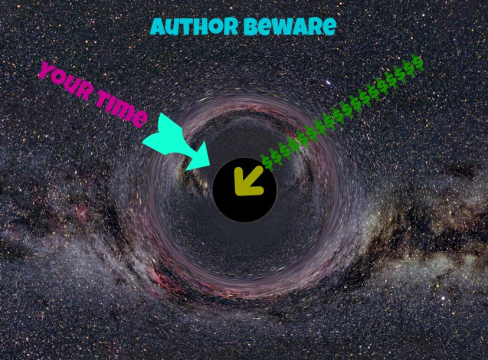
Original image via NASA Blueshift courtesy of Flickr Commons
Catchy :D . The problem is it is SO easy to mistake the urgent for the important (thank you, Mr. Covey). We wash the dishes, clean out the e-mail, volunteer for crap we don’t even WANT to do to impress people we don’t know or even like or are just too chicken to say no…and priorities take the hit.
Priorities will also shift over time…especially if you are hardheaded and been dumb like me. Since I DID NOT make rest a priority? Guess what I got to do THREE MIND-WRECKING months of? Sleep. Trust me. It is no trick for a workaholic to work more. Make them take a nap and wait for the weeping sounds.
Thus, I’ve gone back to my original list of priorities:
My Spirit—For me? I try to start every day with God. I love Andy Stanley, Joyce Meyer, and Craig Groeschel the most. I listen to their lessons while I’m waking up and getting caffeine in my system. I believe God will give me back the time I spend getting spiritually centered. I also take at least ONE FULL day off a week. Resting is now a HUGE priority.
Refreshing our souls is vital, especially creative people. Whether it is a walk, meditation, yoga, reading, or however you get spiritually grounded, ALL things spring from our well. Is our well refreshed and flowing? Or is it stagnant, stinky and floating with bugs?
My Family—My husband takes priority because the best thing for Spawn is to feel safe. Mommy and Daddy in love, working as a team is the best investment in his future. Also, I am enjoying the little boy Spawn is. I can have an aneurism over the 9 zillion Army men on the floor or that he’s sprinkled Chex like fairy dust through the house…or I can enjoy him being little. He will only be FIVE once.
My Writing—Self-explanatory. Yep, laundry needs to be done…after I make a certain word count. My mantra these days?
IT CAN WAIT. If an item isn’t in the first three of YOUR priorities? Odds are, it can wait. It’s urgent masquerading as important ;) .
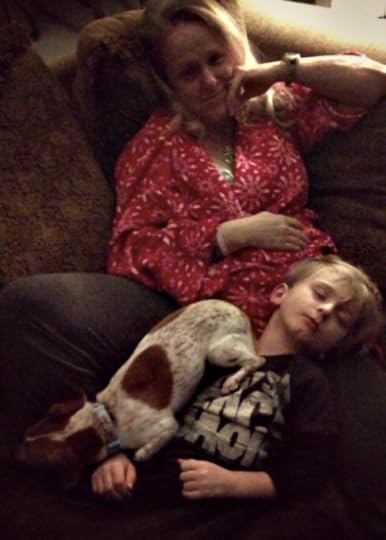
My legs went to sleep an hour ago…
Everything in our lives, our relationship with time, should ideally come after the first three. Writing is not my hobby, my “thing”, my fun. It is fun, but it’s my JOB. If my JOB takes over my spirit and family, bad things happen. If other “priorities” like a perfect yard, crocheting, volunteering, helping others with “their lives” creep into that top three? Time to revisit and recenter.
Time is finite, which means focus is vital. You matter. Your dreams matter. Thing is, only YOU can make them a priority. So take some time and invest in YOU. Brainstorm all the things you want then circle the top three and THAT is where I’d consider placing energy and time.
What are your thoughts? Do you feel like too little butter scraped over too much bread? Is it hard to say no? Have you lost your center and don’t even know what you want? Have you defined your priorities or are you letting others command the agenda? Do you lose too much time in helping others at the expense of YOU? Have you been through burnout? What did you do? Are you there now? Have you kept the same priorities out of habit and not thought about revising the plan? Have you ever gotten SO off-track you made yourself ill? Are you now more vigilant?
I LOVE hearing from you!
To prove it and show my love, for the month of DECEMBER, everyone who leaves a comment I will put your name in a hat. If you comment and link back to my blog on your blog, you get your name in the hat twice. What do you win? The unvarnished truth from yours truly. I will pick a winner once a month and it will be a critique of the first 20 pages of your novel, or your query letter, or your synopsis (5 pages or less).
For those who need help building a platform and keeping it SIMPLE, pick up a copy of my latest social media/branding book Rise of the Machines—Human Authors in a Digital World on AMAZON, iBooks, or Nook.

December 5, 2014
Can Being Tired Make Us Better Writers?

Image via Lauriesanders60 WANACommons
Last month I participated in NaNoWriMo even though it’s the holidays and, as many of you know, I am battling the last vestiges of Shingles which makes me tired, like down to the BONES tired. But, lest I go crazy, I had to write, because that’s what writers do. We aren’t happy unless we are writing something.
I figured in the beginning I likely wouldn’t make the 50,000 word mark not only because of feeling puny, but I also have other writing that doesn’t count toward NaNo.
Yet, the interesting thing is, being tired can have benefits. If we wait until that celestial alignment when the kids aren’t sick, our pants fit, there isn’t a heap of laundry, the garage is clean, the junk mail sorted, and we feel energized? We won’t get a lot of writing done, so here is some food for thought next time you believe you’re too tired to write.
Embrace Being Tired
Okay, first I want to take a moment to acknowledge that we do need rest. We need breaks and days off. Shingles had taught me I am seriously HUMAN. It’s actually humbled me to be better at resting because I love what I do and this makes it easy to overdo.
I’m going to be writing a new NF in 2015, so I needed to REST my left brain and let RIGHT BRAIN have some time to play (ergo NaNo).
Your Body Will Lie to You
Beyond sickness and disasters, our bodies tend to be a bit lazy, and they like to lie. They tell us we need a day or two or twenty off, and the longer we’re away from the work, the easier it is to let things slip, to see a new shiny and start a newer, more exciting project. In this business, time is our enemy. Always remember this.

Image via JulaiLimjl Flikr Creative Commons
It Will Never Be a “Perfect” Time
We want to wait until we’re rested, the kids are out of the house, until we have total quiet, a new computer, the list goes on. To do this job at a professional level, we have to learn to write no matter what. This is a profession, not a playpen. People often groan that NaNoWriMo is in November and there is all this shopping and cleaning and cooking.
Okay, well, I used to work in sales and they still expected my tail to be on the road selling industrial paper from Mexico to Missouri until that scrawny four days off for vaca. If I was sick? I knew when I came back, I had to bust tail to catch up. Family emergency? Okay, tend it, but then back to get your $#!& done.
Coffee was for closers.
Writing (for those who want to make a living at this) should apply the same rules as other professions. Granted, it’s a LOT harder because no boss is going to write us up or chew us out if we don’t write…and most of our family and friends secretly believe all we do is play with our imaginary friends and we don’t have a “real” job. We need A LOT more self-discipline than other jobs.
I write every day but Sunday with a preschooler whacking me 47 times with a NERF sword before breakfast, all the while Paw Patrol is blazing in the background. I’ve learned to un-see the dirty dishes, the laundry that needs folding, and the Christmas tree that was attacked by my cats in the middle of the night and needs triage.
Distractions=Death
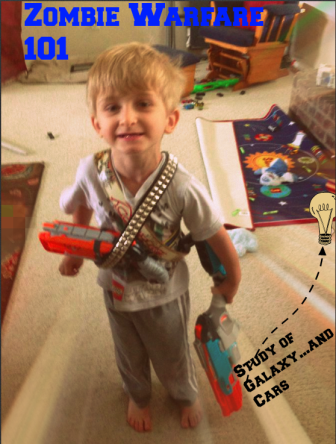
The Spawn
Time is the Enemy
When writing anything (but especially fiction) taking time off can kill momentum. We need to go back, reread, familiarize ourselves with the story and characters (since we’ve slept since that last bit we wrote). This can lead to editing the beginning to death and stalls forward progress. We get bogged down in the first part of the book.
Take too much time? Likely, you’ll have to start all over.
I did. Yes, even NF authors are vulnerable to time. Back in 2011 I scored a premium NYC agent and over a year and a half later? The project was going nowhere. When I finally decided to self-publish my most current social media book, Rise of the Machines—Human Authors in a Digital World, I spent more effort trying to retrofit work I’d done for my agent back in 2011 than I want to admit. Finally, I just scrapped the whole thing and started over. 150 pages of wasted work all because I didn’t keep writing.
My mistake. Won’t happen again.
Sometimes Being Tired Produces Better Writing
I know a lot of you work day jobs, are full-time caregivers, and you’re squeezing in writing when you can. GO YOU! You’re superheroes, and always remember that. Keep pressing.
Yet, one mistake we make is we don’t tackle the novel when we’re tired. We believe our work will be better if we’ve rested.
This isn’t necessarily true.
Candy runs a workshop she calls Fast Draft. In Fast Draft, you write your novel in two weeks. It is one of the toughest challenges I’ve ever done, but it works. No editing, no going back, just keep going forward. By Day Three, I promise you’ll feel like you’ve been tossed in a bag of hammers and shaken.
BUT…
One of the biggest enemies of great fiction is Conscious Mind. Our internal editor lives there and won’t let us move forward until we get rid of “was clusters” or add more detail to that “jungle scene.” Conscious Mind will have you “being responsible” and browsing the Internet looking at South American plants instead of writing.
Conscious Mind is the Bigger Sibling Who Constantly Calls Little Sister (Subconscious Mind) Stupid and Tells Her to Shut Up

Image via Life Mental health Flikr Creative Commons
Subconscious Mind is the primal mind. It sees things we don’t, makes connections Conscious Mind, also known as “The Thinking Brain”, misses. Thinking Brain is a bit of a Bossy Pants and likes to shove Subconscious Mind around, give it wedgies and promise that it can jump off the roof with an umbrella and float down.
Hey, Penguin does it all the time.
The best way to get your Subconscious Mind to help you is to wear the bigger, bossier sibling out. This allows the Little Guy an opportunity to help you make magic without the bigger sibling butting in.
Conscious Mind is the Inner Editor, the Inner Critic, the Nit-Picker, whereas the Subconscious Mind (the Limbic and “primitive” brain) is the one who sees value in finger painting and advantages of glitter.
Subconscious Mind will thrust you deeper into the story. Subconscious Mind is like a toddler who jumps head-first off the couch. No fear. There will be greater emotion and the writing often is more visceral. Subconscious Mind plants Seeds of Awesomeness that you will see flower into something more amazing that you believed you were capable of.
But that won’t happen unless Conscious Mind is exhausted and too tired to argue and bully it’s littler sibling.
So if you’re struggling with the WIP, you might just be a little “too rested.” This isn’t to say we don’t take care of ourselves, but total immersion and pressing on even when we’re worn out and would trade everything we own for a nap does have major advantages.
It’s also why I didn’t kill myself to make the 50,000 words for NaNo, but am still plugging. If I take too much time away from the novel, I KNOW I can cause myself more grief than I care to deal with.
Have you ever done a fast draft? Did it help? Do you write even when you’re tired? What has that shown you? What are your thoughts? Questions? War stories?
I love hearing from you!
To prove it and show my love, for the month of DECEMBER, everyone who leaves a comment I will put your name in a hat. If you comment and link back to my blog on your blog, you get your name in the hat twice. What do you win? The unvarnished truth from yours truly. I will pick a winner once a month and it will be a critique of the first 20 pages of your novel, or your query letter, or your synopsis (5 pages or less).
For those who need help building a platform and keeping it SIMPLE, pick up a copy of my latest social media/branding book Rise of the Machines—Human Authors in a Digital World on AMAZON, iBooks, or Nook.


